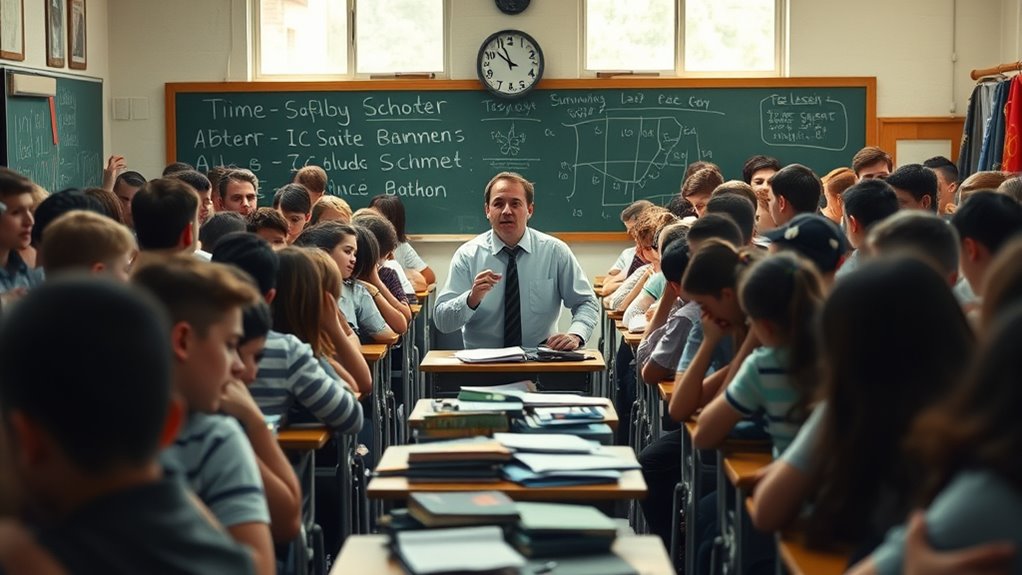Teacher shortages happen because low pay, burnout, and unstable work environments make the job less appealing. As a result, classrooms become crowded, and students face less support, affecting their learning. To fix this, improving salaries, offering professional growth, and creating positive school cultures are essential. If you want to understand how these issues develop and what solutions work, keep exploring the causes, impacts, and ways to address this pressing issue.
Key Takeaways
- Teacher shortages stem from high attrition rates, burnout, and inadequate compensation, leading to staffing instability.
- Impacts include disrupted learning, decreased student engagement, and overcrowded classrooms.
- Contributing factors are low salaries, lack of support, and limited professional development opportunities.
- Economic and emotional challenges, such as pay gaps and feeling undervalued, drive teachers to leave the profession.
- Solutions involve improving pay, fostering supportive environments, offering mentorship, and enhancing professional growth opportunities.

Have you noticed how many schools are struggling to fill teaching positions? It’s a problem that’s becoming more visible across districts nationwide. One of the core issues behind this shortage is the challenge of maintaining high student retention rates. When teachers leave prematurely, it disrupts the learning environment and creates a cycle of instability that deters new educators from staying long-term. Schools with high turnover often find it difficult to build strong, consistent relationships with students, which can lead to decreased engagement and achievement. This cycle makes it even harder to attract new teachers, who may be hesitant to enter a field perceived as unstable or unfulfilling.
Another significant factor fueling teacher shortages is salary disparities. Many teachers feel undercompensated for the demanding work they do, especially when comparing their pay to other professions requiring similar education levels. These disparities can be especially discouraging for new teachers, who often face student loan debt and financial pressures. When salaries are not competitive, prospective educators may choose careers outside of teaching, further depleting the pool of qualified candidates. Existing teachers might also leave for better-paying jobs, compounding the staffing problem. This pay gap isn’t just about individual earnings—it also impacts morale, job satisfaction, and the overall attractiveness of the teaching profession.
The combination of low student retention and salary disparities creates a challenging environment for school administrators trying to fill positions. Many educators leave early in their careers due to burnout, stress, or feeling undervalued, which ties back to inadequate compensation and lack of support. Meanwhile, the ongoing shortage discourages talented individuals from even considering teaching as a viable career path. As a result, classrooms become more crowded, and the quality of education suffers, further reducing student retention and achievement. It’s a vicious cycle that feeds into itself, making it harder to stabilize the workforce. Additionally, the lack of professional development opportunities**** can further diminish teachers’ motivation and retention, worsening the cycle.
To address these issues, schools need to focus on improving compensation and creating supportive work environments. Offering competitive salaries, along with professional development opportunities and mentorship programs, can help attract and keep teachers longer. Additionally, fostering a positive school culture that values teachers’ contributions can improve retention rates. When teachers feel respected, supported, and adequately paid, they’re more likely to stay committed to their students and their careers. Breaking this cycle requires a multifaceted approach that tackles both the economic and emotional aspects of teaching. Only then can we begin to resolve the persistent shortages and build a stronger, more sustainable education system.
Frequently Asked Questions
How Do Teacher Shortages Vary Across Different Regions?
You’ll notice that teacher shortages vary greatly across regions, highlighting significant disparities. Urban areas often attract more teachers due to better pay and resources, while rural regions face severe shortages because of isolation and fewer opportunities. This urban versus rural divide worsens educational inequality, making it harder for students in less served areas to access quality teaching. Addressing these regional disparities requires targeted policies to support teachers everywhere, especially in underserved rural communities.
What Roles Do Technology and Online Teaching Play in Addressing Shortages?
Technology and online teaching help ease teacher shortages by creating digital classrooms, allowing you to reach more students remotely. You can also participate in virtual mentorship programs, supporting new teachers and sharing expertise regardless of location. These tools make it easier to fill gaps quickly, giving you flexible options to improve education access and quality, especially in underserved areas. Embracing digital solutions is key to addressing the ongoing teacher shortage.
How Do Teacher Shortages Impact Student Academic Performance Long-Term?
Ever wonder how teacher shortages affect your child’s future? When classes are understaffed, students often experience decreased engagement and disrupted learning routines. This leads to lower learning retention, making it harder for them to build foundational skills. Over time, these gaps can hinder academic progress, limiting opportunities and confidence. You might ask, how can we guarantee consistent quality education despite staffing challenges? Addressing shortages is vital for long-term student success.
Are There Specific Subject Areas More Affected by Shortages?
You’ll notice that specialized shortages hit certain subject areas harder, especially STEM fields like math and science, as well as special education. These subject-specific challenges make it harder for schools to find qualified teachers, which can lower student engagement and achievement. When shortages persist, students miss out on essential skills in these critical areas, impacting their future opportunities and overall academic progress.
What Policies Have Successfully Mitigated Teacher Shortages Historically?
You’ll find that incentive programs and teacher residencies have successfully mitigated shortages. For example, states with robust incentive programs see a 15% increase in teaching candidates. These policies attract new teachers and retain experienced ones by offering financial rewards and practical training. Implementing targeted incentives and residency programs encourages more individuals to enter and stay in the profession, helping to stabilize staffing and improve educational quality nationwide.
Conclusion
As the school doors close each day, the empty classrooms stand as silent witnesses to a growing crisis. Teacher shortages threaten to dim the bright future students deserve, like a fading lighthouse guiding ships home. But with collective effort, we can reignite that beacon of hope. Your actions can be the spark to restore the guiding light, ensuring every child’s journey is filled with knowledge, care, and opportunity. Together, we hold the power to turn darkness into dawn.










